steering BMW Z4 M ROADSTER&COUPE 2007 Owners Manual
[x] Cancel search | Manufacturer: BMW, Model Year: 2007, Model line: Z4 M ROADSTER&COUPE, Model: BMW Z4 M ROADSTER&COUPE 2007Pages: 50, PDF Size: 3.21 MB
Page 10 of 50

Cockpit
8
Cockpit
Around the steering wheel: controls and displays
For descriptions of equipment listed here
without a page reference, please refer to
the Owner's Manual for the BMW Z4 under the
respective term. <
2 Folding exterior mirrors in or out
*
3Adjusting exterior mirrors
1
Opening and closing windows
4
Parking lamps
Low beams
Automatic headlamp control
*
5Instrument lighting
Page 11 of 50
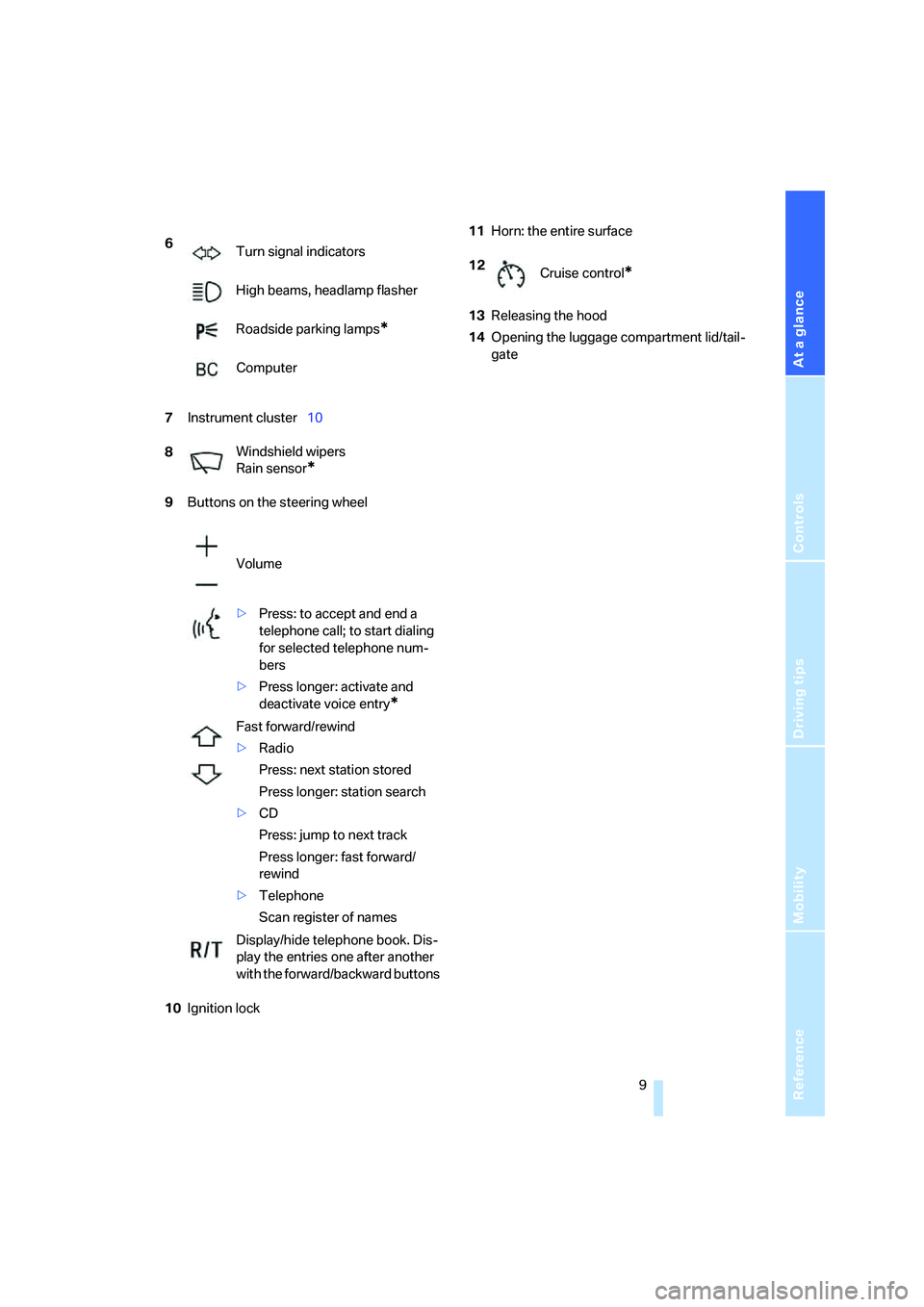
At a glance
Controls
Driving tips
Mobility
Reference
9
7 Instrument cluster 10
9 Buttons on the steering wheel
10 Ignition lock 11
Horn: the entire surface
13 Releasing the hood
14 Opening the luggage compartment lid/tail-
gate
6
Turn signal indicators
High beams, headlamp flasher
Roadside parking lamps
*
Computer
8 Windshield wipers
Rain sensor
*
Volume
>
Press: to accept and end a
telephone call; to start dialing
for selected telephone num-
bers
> Press longer: activate and
deactivate voice entry
*
Fast forward/rewind
>Radio
Press: next station stored
Press longer: station search
> CD
Press: jump to next track
Press longer: fast forward/
rewind
> Telephone
Scan register of names
Display/hide telephone book. Dis-
play the entries one after another
with the forward/backward buttons
12 Cruise control*
Page 20 of 50
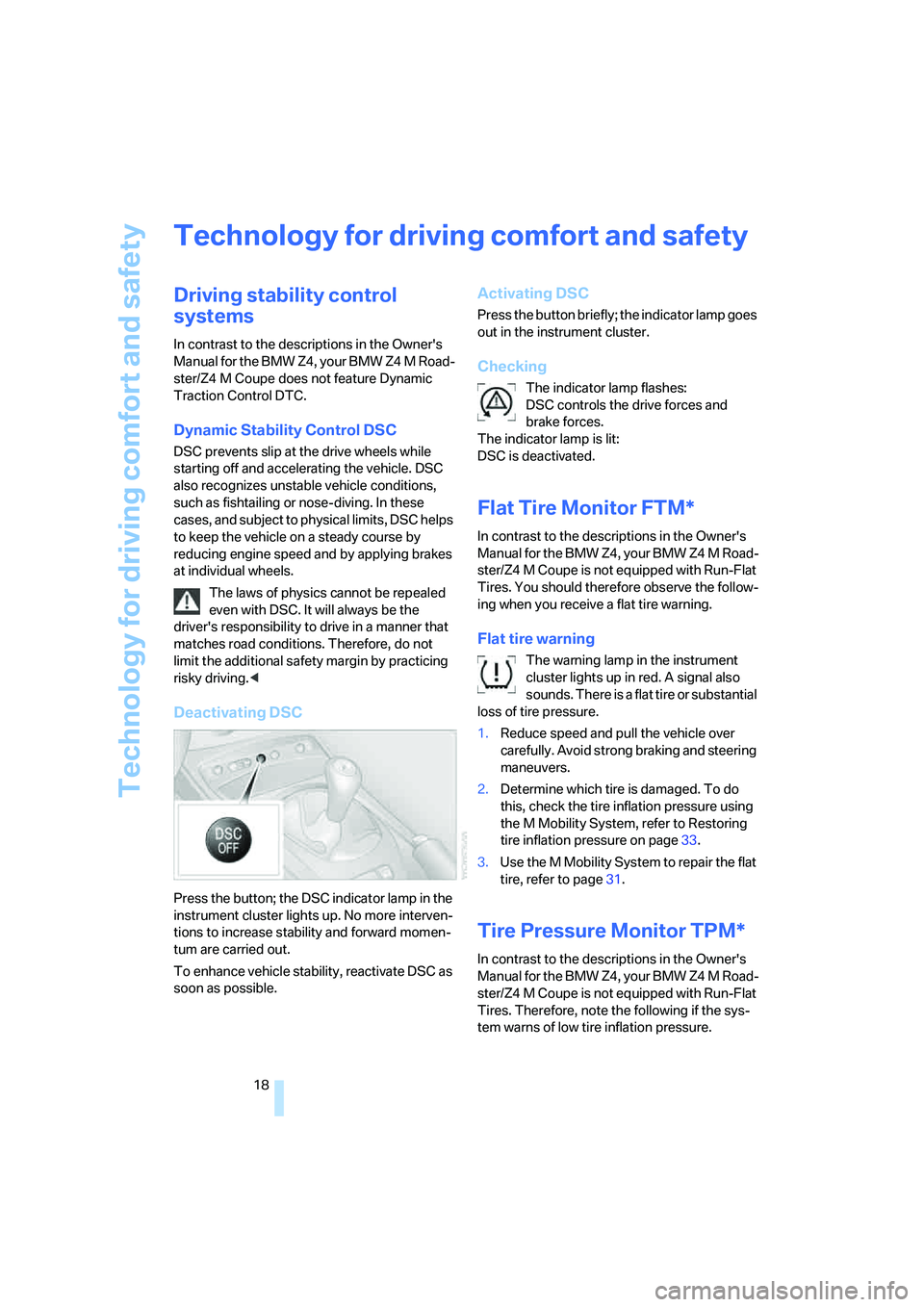
Technology for driving comfort and safety
18
Technology for driving comfort and safety
Driving stability control
systems
In contrast to the descriptions in the Owner's
Manual for the BMW Z4, your BMW Z4 M Road-
ster/Z4 M Coupe does not feature Dynamic
Traction Control DTC.
Dynamic Stability Control DSC
DSC prevents slip at the drive wheels while
starting off and accelerating the vehicle. DSC
also recognizes unstable vehicle conditions,
such as fishtailing or nose-diving. In these
cases, and subject to physical limits, DSC helps
to keep the vehicle on a steady course by
reducing engine speed and by applying brakes
at individual wheels.
The laws of physics cannot be repealed
even with DSC. It will always be the
driver's responsibility to drive in a manner that
matches road conditions. Therefore, do not
limit the additional safety margin by practicing
risky driving. <
Deactivating DSC
Press the button; the DSC indicator lamp in the
instrument cluster lights up. No more interven-
tions to increase stability and forward momen-
tum are carried out.
To enhance vehicle stability, reactivate DSC as
soon as possible.
Activating DSC
Press the button briefly; the indicator lamp goes
out in the instrument cluster.
Checking
The indicator lamp flashes:
DSC controls the drive forces and
brake forces.
The indicator lamp is lit:
DSC is deactivated.
Flat Tire Monitor FTM*
In contrast to the descriptions in the Owner's
Manual for the BMW Z4, your BMW Z4 M Road-
ster/Z4 M Coupe is not equipped with Run-Flat
Tires. You should therefore observe the follow-
ing when you receive a flat tire warning.
Flat tire warning
The warning lamp in the instrument
cluster lights up in red. A signal also
sounds. There is a flat tire or substantial
loss of tire pressure.
1. Reduce speed and pull the vehicle over
carefully. Avoid strong braking and steering
maneuvers.
2. Determine which tire is damaged. To do
this, check the tire inflation pressure using
the M Mobility System, refer to Restoring
tire inflation pressure on page 33.
3. Use the M Mobility System to repair the flat
tire, refer to page 31.
Tire Pressure Monitor TPM*
In contrast to the descriptions in the Owner's
Manual for the BMW Z4, your BMW Z4 M Road-
ster/Z4 M Coupe is not equipped with Run-Flat
Tires. Therefore, note the following if the sys-
tem warns of low tire inflation pressure.
Page 21 of 50
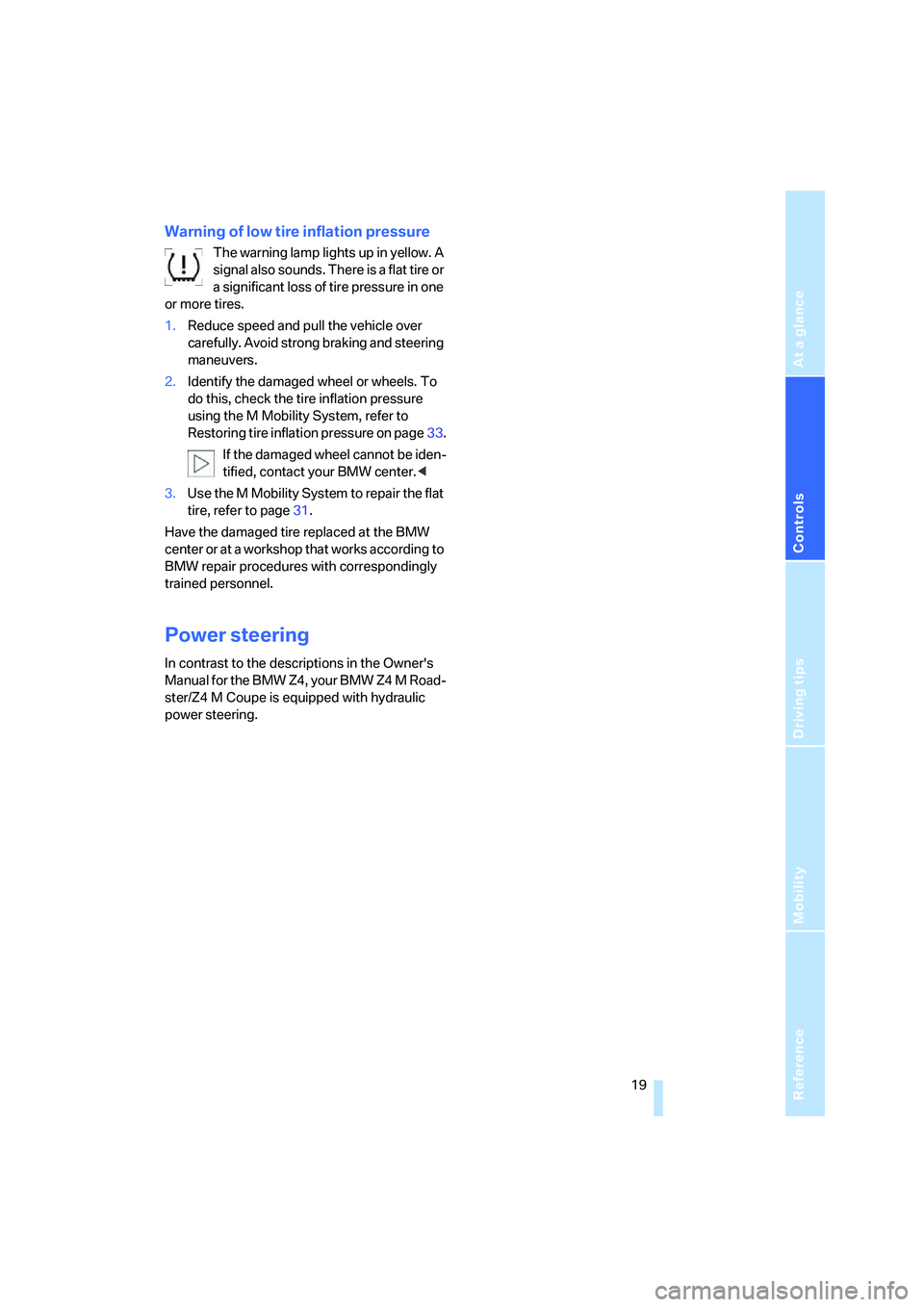
Reference
At a glance
Controls
Driving tips
Mobility
19
Warning of low tire inflation pressure
The warning lamp lights up in yellow. A
signal also sounds. There is a flat tire or
a significant loss of tire pressure in one
or more tires.
1. Reduce speed and pull the vehicle over
carefully. Avoid strong braking and steering
maneuvers.
2. Identify the damaged wheel or wheels. To
do this, check the tire inflation pressure
using the M Mobility System, refer to
Restoring tire inflation pressure on page 33.
If the damaged wheel cannot be iden-
tified, contact your BMW center. <
3. Use the M Mobility System to repair the flat
tire, refer to page 31.
Have the damaged tire replaced at the BMW
center or at a workshop that works according to
BMW repair procedures with correspondingly
trained personnel.
Power steering
In contrast to the descriptions in the Owner's
Manual for the BMW Z4, your BMW Z4 M Road-
ster/Z4 M Coupe is equipped with hydraulic
power steering.
Page 31 of 50
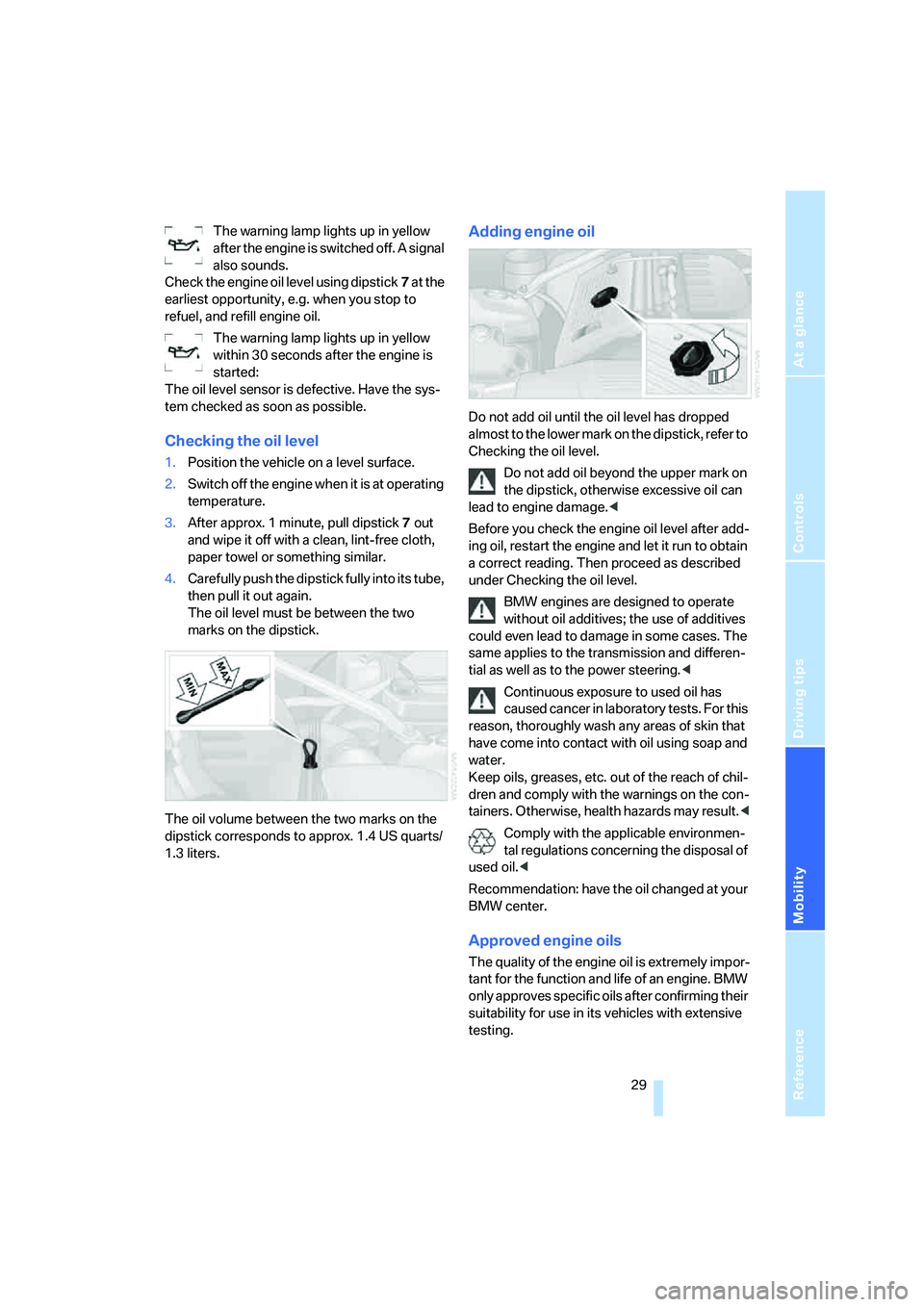
Reference
At a glance
Controls
Driving tips
Mobility
29
The warning lamp lights up in yellow
after the engine is switched off. A signal
also sounds.
Check the engine oil level using dipstick 7 at the
earliest opportunity, e. g. when you stop to
refuel, and refill engine oil.
The warning lamp lights up in yellow
within 30 seconds after the engine is
started:
The oil level sensor is defective. Have the sys-
tem checked as soon as possible.
Checking the oil level
1. Position the vehicle on a level surface.
2. Switch off the engine when it is at operating
temperature.
3. After approx. 1 minute, pull dipstick 7 out
and wipe it off with a clean, lint-free cloth,
paper towel or something similar.
4. Carefully push the dipstick fully into its tube,
then pull it out again.
The oil level must be between the two
marks on the dipstick.
The oil volume between the two marks on the
dipstick corresponds to approx. 1.4 US quarts/
1.3 liters.
Adding engine oil
Do not add oil until the oil level has dropped
almost to the lower mark on the dipstick, refer to
Checking the oil level. Do not add oil beyond the upper mark on
the dipstick, otherwise excessive oil can
lead to engine damage. <
Before you check the engine oil level after add-
ing oil, restart the engine and let it run to obtain
a correct reading. Then proceed as described
under Checking the oil level. BMW engines are designed to operate
without oil additives; the use of additives
could even lead to damage in some cases. The
same applies to the transmission and differen-
tial as well as to the power steering. <
Continuous exposure to used oil has
caused cancer in laboratory tests. For this
reason, thoroughly wash any areas of skin that
have come into contact with oil using soap and
water.
Keep oils, greases, etc. out of the reach of chil-
dren and comply with the warnings on the con-
tainers. Otherwise, health hazards may result. <
Comply with the applicable environmen-
tal regulations concerning the disposal of
used oil. <
Recommendation: have the oil changed at your
BMW center.
Approved engine oils
The quality of the engine oil is extremely impor-
tant for the function and life of an engine. BMW
only approves specific oils after confirming their
suitability for use in its vehicles with extensive
testing.
Page 33 of 50
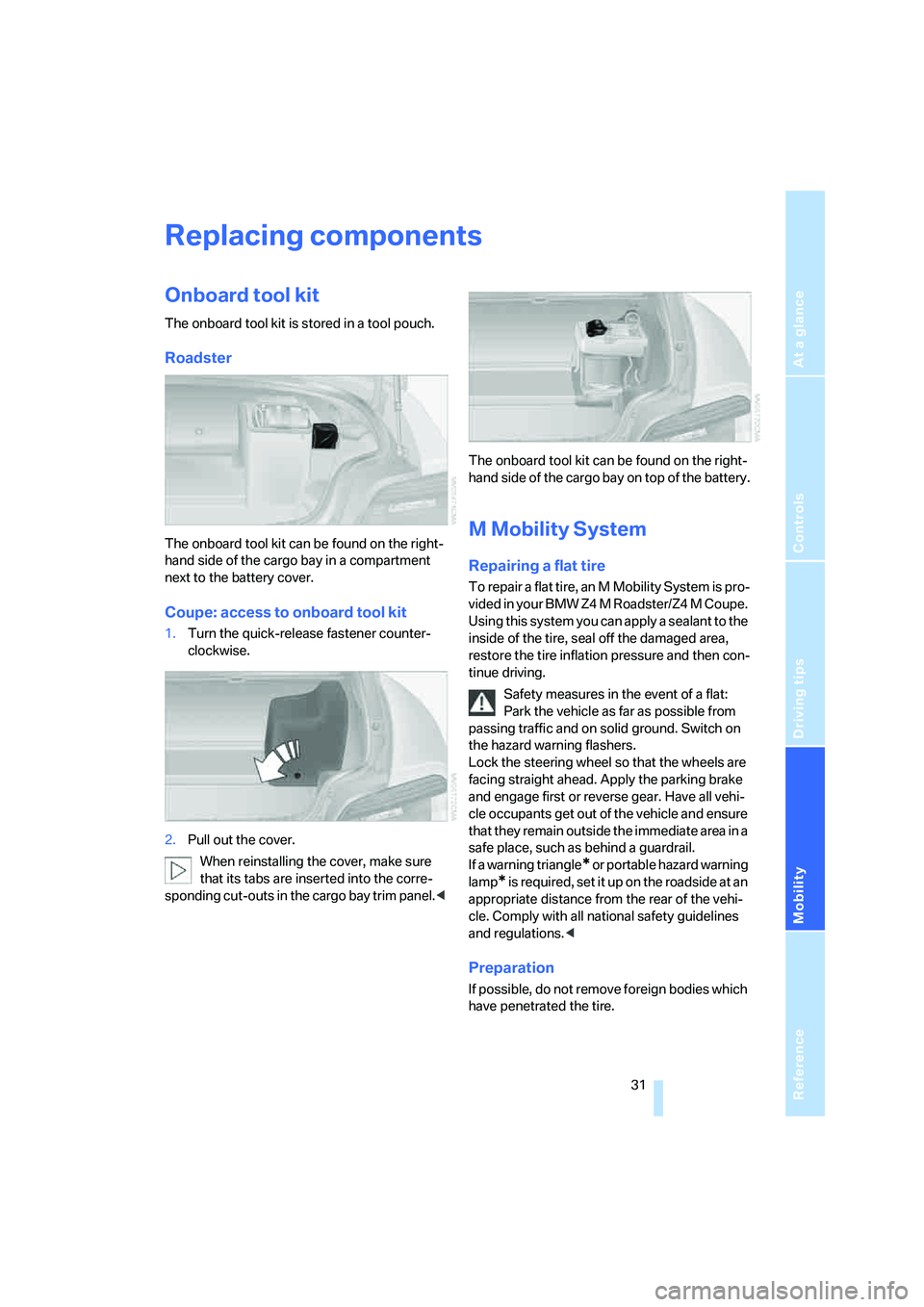
Reference
At a glance
Controls
Driving tips
Mobility
31
Replacing components
Onboard tool kit
The onboard tool kit is stored in a tool pouch.
Roadster
The onboard tool kit can be found on the right-
hand side of the cargo bay in a compartment
next to the battery cover.
Coupe: access to onboard tool kit
1.Turn the quick-release fastener counter-
clockwise.
2. Pull out the cover.
When reinstalling the cover, make sure
that its tabs are inserted into the corre-
sponding cut-outs in the cargo bay trim panel.
M Mobility System
Repairing a flat tire
To repair a flat tire, an M Mobility System is pro-
vided in your BMW Z4 M Roadster/Z4 M Coupe.
Using this system you can apply a sealant to the
inside of the tire, seal off the damaged area,
restore the tire inflation pressure and then con-
tinue driving.
Safety measures in the event of a flat:
Park the vehicle as far as possible from
passing traffic and on solid ground. Switch on
the hazard warning flashers.
Lock the steering wheel so that the wheels are
facing straight ahead. Apply the parking brake
and engage first or reve rse gear. Have all vehi-
cle occupants get out of the vehicle and ensure
that they remain outside the immediate area in a
safe place, such as behind a guardrail.
If a warning triangle
* or portable hazard warning
lamp
* is required, set it up on the roadside at an
appropriate distance from the rear of the vehi-
cle. Comply with all national safety guidelines
and regulations. <
Preparation
If possible, do not remove foreign bodies which
have penetrated the tire.
Page 34 of 50
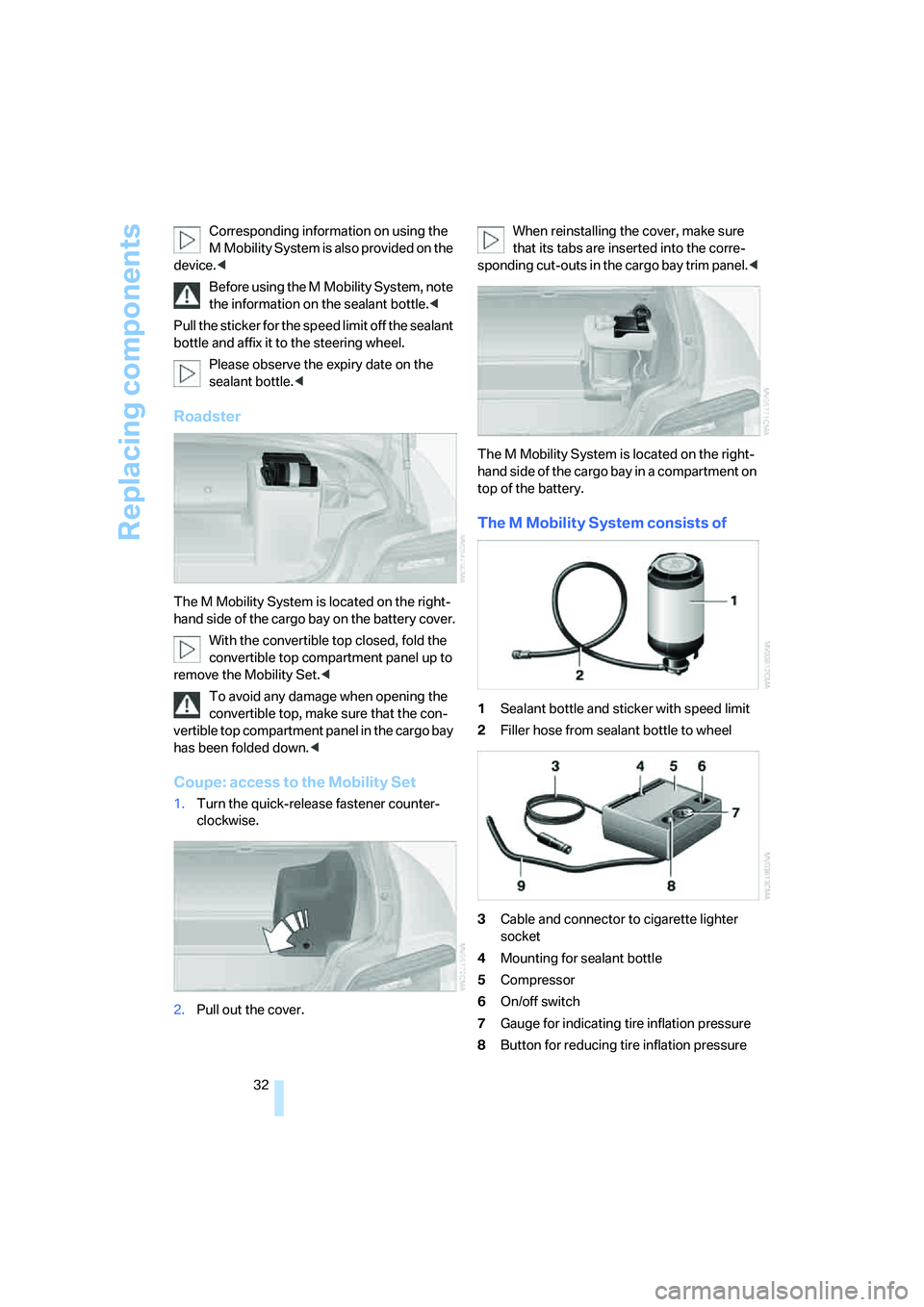
Replacing components
32
Corresponding information on using the
M Mobility System is also provided on the
device. <
Before using the M Mobility System, note
the information on the sealant bottle. <
Pull the sticker for the sp eed limit off the sealant
bottle and affix it to the steering wheel.
Please observe the expiry date on the
sealant bottle. <
Roadster
The M Mobility System is located on the right-
hand side of the cargo bay on the battery cover.
With the convertible top closed, fold the
convertible top compartment panel up to
remove the Mobility Set. <
To avoid any damage when opening the
convertible top, make sure that the con-
vertible top compartment panel in the cargo bay
has been folded down. <
Coupe: access to the Mobility Set
1.Turn the quick-release fastener counter-
clockwise.
2. Pull out the cover. When reinstalling the cover, make sure
that its tabs are inserted into the corre-
sponding cut-outs in the cargo bay trim panel. <
The M Mobility System is located on the right-
hand side of the cargo bay in a compartment on
top of the battery.
The M Mobility System consists of
1 Sealant bottle and sticker with speed limit
2 Filler hose from sealant bottle to wheel
3 Cable and connector to cigarette lighter
socket
4 Mounting for sealant bottle
5 Compressor
6 On/off switch
7 Gauge for indicating tire inflation pressure
8 Button for reducing tire inflation pressure
Page 44 of 50
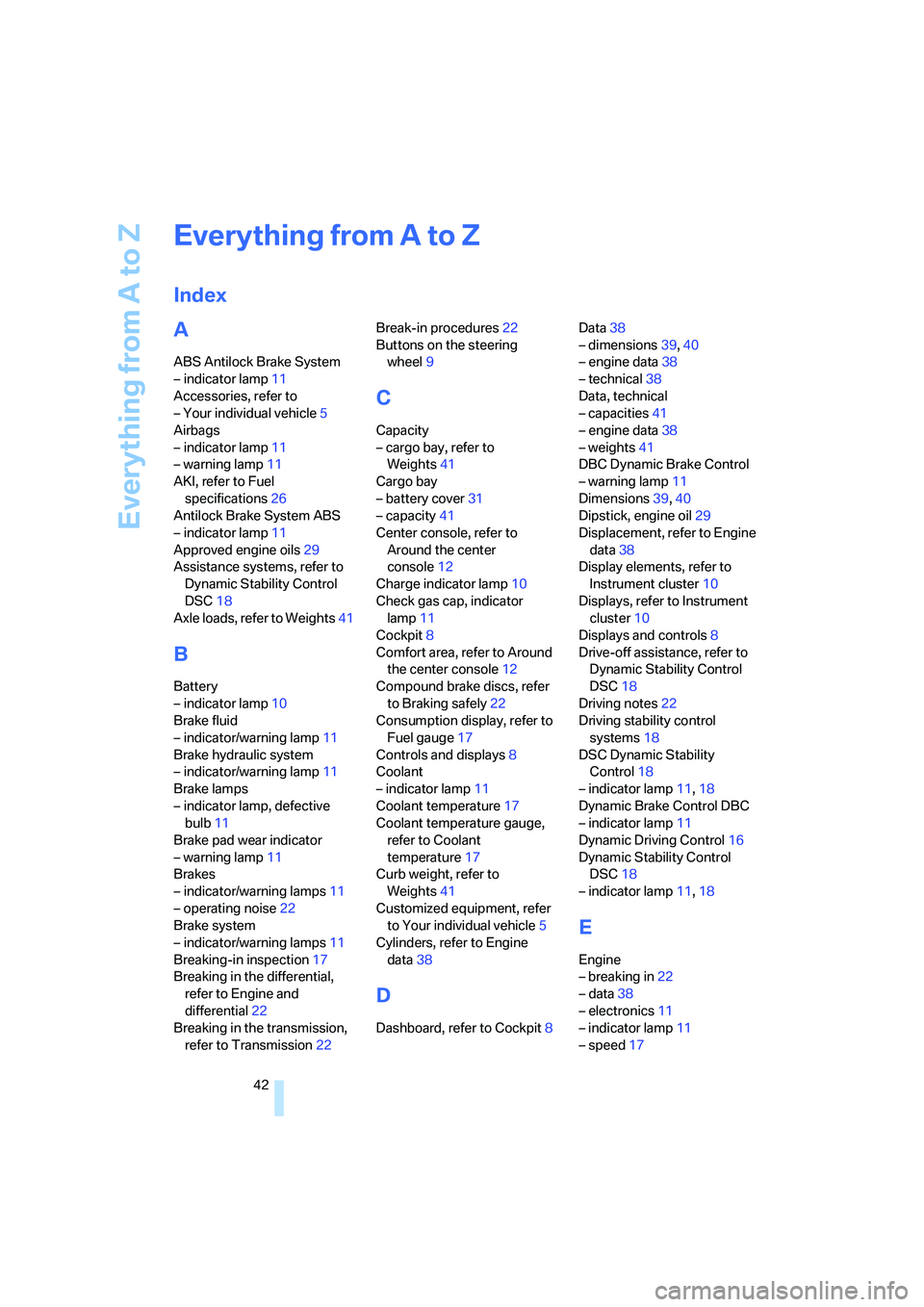
Everything from A to Z
42
Everything from A to Z
Index
A
ABS Antilock Brake System
– indicator lamp11
Accessories, refer to
– Your individual vehicle 5
Airbags
– indicator lamp 11
– warning lamp 11
AKI, refer to Fuel specifications 26
Antilock Brake System ABS
– indicator lamp 11
Approved engine oils 29
Assistance systems, refer to
Dynamic Stability Control
DSC 18
Axle loads, refer to Weights 41
B
Battery
– indicator lamp10
Brake fluid
– indicator/warning lamp 11
Brake hydraulic system
– indicator/warning lamp 11
Brake lamps
– indicator lamp, defective bulb 11
Brake pad wear indicator
– warning lamp 11
Brakes
– indicator/warning lamps 11
– operating noise 22
Brake system
– indicator/warning lamps 11
Breaking-in inspection 17
Breaking in the differential,
refer to Engine and
differential 22
Breaking in the transmission,
refer to Transmission 22Break-in procedures
22
Buttons on the steering wheel 9
C
Capacity
– cargo bay, refer to
Weights 41
Cargo bay
– battery cover 31
– capacity 41
Center console, refer to Around the center
console 12
Charge indicator lamp 10
Check gas cap, indicator lamp 11
Cockpit 8
Comfort area, refer to Around the center console 12
Compound brake discs, refer to Braking safely 22
Consumption display, refer to
Fuel gauge 17
Controls and displays 8
Coolant
– indicator lamp 11
Coolant temperature 17
Coolant temperature gauge,
refer to Coolant
temperature 17
Curb weight, refer to
Weights 41
Customized equipment, refer to Your individual vehicle 5
Cylinders, refer to Engine data 38
D
Dashboard, refer to Cockpit 8Data
38
– dimensions 39,40
– engine data 38
– technical 38
Data, technical
– capacities 41
– engine data 38
– weights 41
DBC Dynamic Brake Control
– warning lamp 11
Dimensions 39,40
Dipstick, engine oil 29
Displacement, refer to Engine data 38
Display elements, refer to
Instrument cluster 10
Displays, refer to Instrument cluster 10
Displays and controls 8
Drive-off assistance, refer to Dynamic Stability Control
DSC 18
Driving notes 22
Driving stability control
systems 18
DSC Dynamic Stability Control 18
– indicator lamp 11,18
Dynamic Brake Control DBC
– indicator lamp 11
Dynamic Driving Control 16
Dynamic Stability Control DSC 18
– indicator lamp 11,18
E
Engine
– breaking in 22
– data 38
– electronics 11
– indicator lamp 11
– speed 17
Page 46 of 50
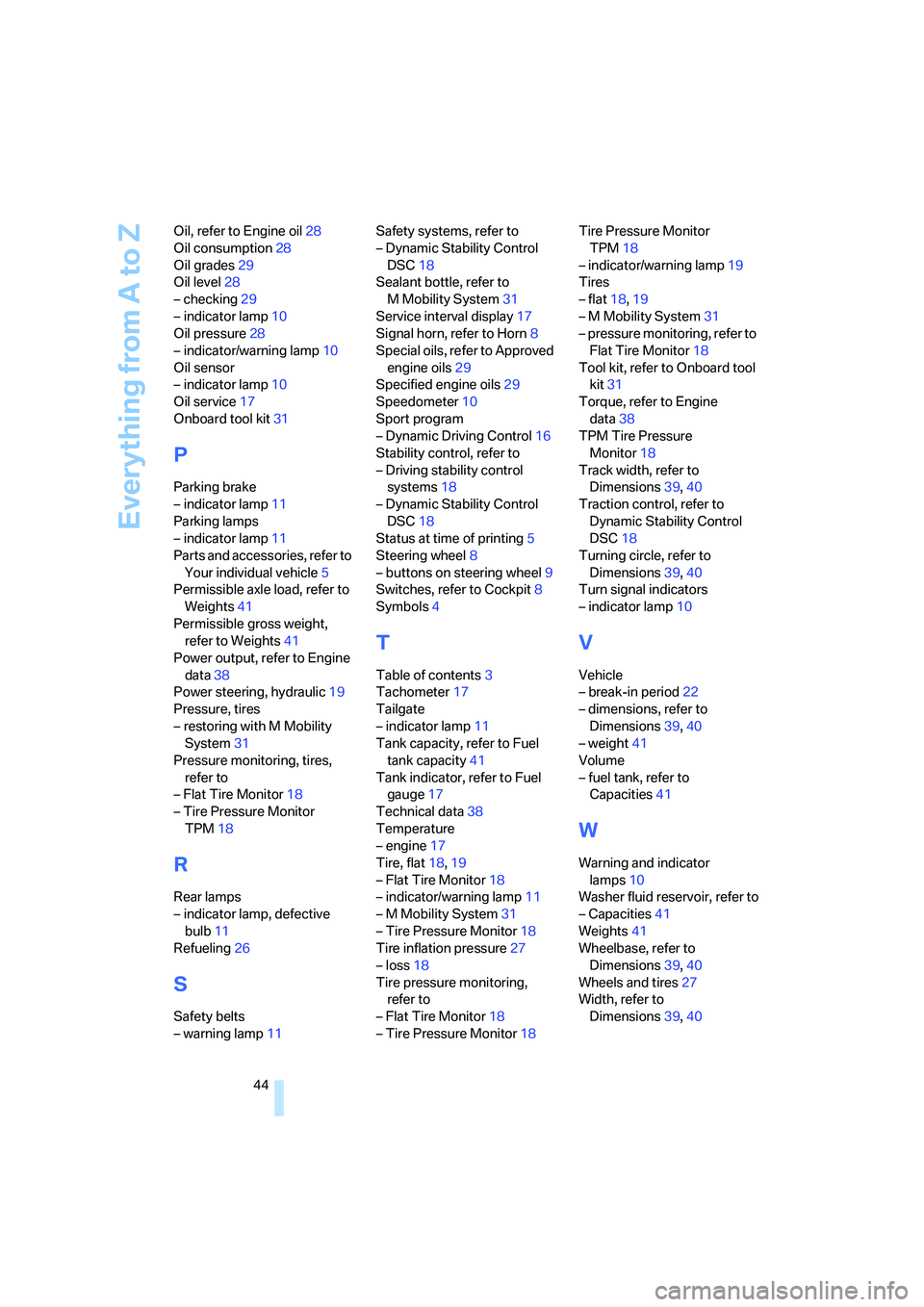
Everything from A to Z
44
Oil, refer to Engine oil
28
Oil consumption 28
Oil grades 29
Oil level 28
– checking 29
– indicator lamp 10
Oil pressure 28
– indicator/warning lamp 10
Oil sensor
– indicator lamp 10
Oil service 17
Onboard tool kit 31
P
Parking brake
– indicator lamp11
Parking lamps
– indicator lamp 11
Parts and accessories, refer to Your individual vehicle 5
Permissible axle load, refer to
Weights 41
Permissible gross weight, refer to Weights 41
Power output, refer to Engine data 38
Power steering, hydraulic 19
Pressure, tires
– restoring with M Mobility System 31
Pressure monitoring, tires, refer to
– Flat Tire Monitor 18
– Tire Pressure Monitor TPM 18
R
Rear lamps
– indicator lamp, defective
bulb 11
Refueling 26
S
Safety belts
– warning lamp 11 Safety systems, refer to
– Dynamic Stability Control
DSC 18
Sealant bottle, refer to
M Mobility System 31
Service interval display 17
Signal horn, refer to Horn 8
Special oils, refer to Approved engine oils 29
Specified engine oils 29
Speedometer 10
Sport program
– Dynamic Driving Control 16
Stability control, refer to
– Driving stability control systems 18
– Dynamic Stability Control DSC 18
Status at time of printing 5
Steering wheel 8
– buttons on steering wheel 9
Switches, refer to Cockpit 8
Symbols 4
T
Table of contents 3
Tachometer 17
Tailgate
– indicator lamp 11
Tank capacity, refer to Fuel
tank capacity 41
Tank indicator, refer to Fuel gauge 17
Technical data 38
Temperature
– engine 17
Tire, flat 18,19
– Flat Tire Monitor 18
– indicator/warning lamp 11
– M Mobility System 31
– Tire Pressure Monitor 18
Tire inflation pressure 27
– loss 18
Tire pressure monitoring, refer to
– Flat Tire Monitor 18
– Tire Pressure Monitor 18Tire Pressure Monitor
TPM 18
– indicator/warning lamp 19
Tires
– flat 18,19
– M Mobility System 31
– pressure monitoring, refer to
Flat Tire Monitor 18
Tool kit, refer to Onboard tool kit 31
Torque, refer to Engine data 38
TPM Tire Pressure
Monitor 18
Track width, refer to Dimensions 39,40
Traction control, refer to Dynamic Stability Control
DSC 18
Turning circle, refer to Dimensions 39,40
Turn signal indicators
– indicator lamp 10
V
Vehicle
– break-in period 22
– dimensions, refer to Dimensions 39,40
– weight 41
Volume
– fuel tank, refer to Capacities 41
W
Warning and indicator
lamps 10
Washer fluid reservoir, refer to
– Capacities 41
Weights 41
Wheelbase, refer to
Dimensions 39,40
Wheels and tires 27
Width, refer to
Dimensions 39,40